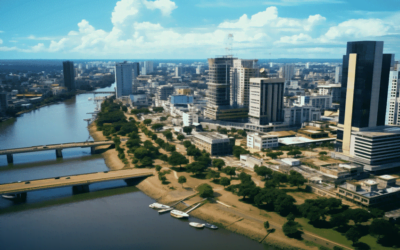Hey there, drone enthusiasts! Ever found yourself lost in the labyrinth of Bangladesh’s drone regulations, desperately seeking clarity? I get it.
Diving into the world of drone laws can be as complex as the intricate flight patterns of our beloved drones.
You’re not alone in this quest for understanding, and I’ve been right where you are, navigating the maze of rules and regulations that govern drone usage in Bangladesh.
In my pursuit of unraveling the mysteries of Bangladesh drone laws, I embarked on an in-depth research journey.
Picture this: diving into the official documents, understanding the nuances of Civil Aviation Authority of Bangladesh (CAAB) regulations, and decoding the intricate legal language.
Why? I wanted to ensure you have the most accurate and reliable information at your fingertips.
Imagine having a knowledgeable friend who has done the homework for you, ready to share insights and demystify the complexities of drone regulations.
So, you might be wondering, “How can I fly my drone legally in Bangladesh?” Well, buckle up, because I’ve got the answers you’ve been searching for.
In this article, I’ve distilled my research findings into an easy-to-understand guide that not only addresses your concerns but also empowers you to take to the skies confidently and legally.
Whether you’re a hobbyist capturing breathtaking aerial shots or a professional utilizing drones for various applications, this article is tailored just for you.
Ready to soar through the realm of Bangladesh drone laws with confidence? Keep reading, and let’s navigate these regulatory skies together.
Your drones are about to take flight, armed with the knowledge you need to ensure a safe and legal journey. Let’s dive in!
- Overview of Regulatory Body in Bangladesh
- Registration and Licensing Requirements
- Bangladesh Operational Restrictions
- Commercial Use of Drones in Bangladesh
- Importation and Customs Regulations
- Bangladesh Safety and Insurance for Drones
- Future Trends and Developments
- Case Studies and Examples in Bangladesh
- Final Thoughts on Bangladesh Drone Laws
- Frequently Asked Questions on Bangladesh Drone Laws
Overview of Regulatory Body in Bangladesh

Let me paint a picture for you: imagine the vast skies of Bangladesh, dotted with drones of all shapes and sizes, each soaring gracefully under the watchful eye of an invisible guardian.
That guardian, my friend, is the Civil Aviation Authority of Bangladesh (CAAB). Now, you might be wondering: What exactly does the CAAB do?
Role and Responsibilities of the Civil Aviation Authority of Bangladesh (CAAB)
Think of the CAAB as the diligent custodian of the airspace above Bangladesh. Their role is pivotal; they set the rules, the dos, and the don’ts that govern the flight of every drone that graces the Bangladeshi skies.
They establish the maximum altitudes, the restricted zones, and the protocols that ensure not just the safety of our drones but also the safety of everyone on the ground.
Picture them as the traffic police of the aerial highways, ensuring a smooth and accident-free journey for every drone enthusiast.
But it’s not just about regulations and restrictions. The CAAB also plays a crucial role in fostering innovation and responsible drone usage.
They provide guidelines for drone manufacturers and operators, ensuring that the technology keeps advancing while maintaining the highest standards of safety and ethics.
In essence, they are the architects of a harmonious coexistence between humans and drones, ensuring that our skies remain vibrant and secure.
Collaboration with Other Government Agencies
Now, let’s talk collaboration. Imagine a symphony where every instrument plays in perfect harmony, creating a beautiful melody.
That’s precisely how the CAAB collaborates with other government agencies. They work hand in hand with law enforcement agencies, environmental bodies, and even local communities to address concerns, prevent misuse, and protect the environment.
This collaborative effort ensures that drones aren’t just gadgets in the sky but tools that benefit society as a whole.
Through this partnership, they strike a balance between innovation and regulation. They nurture the drone industry, encouraging entrepreneurs and enthusiasts to explore the endless possibilities of unmanned aerial systems.
Together, these agencies create an environment where drones are not just a hobby or a profession; they become a force for good, driving progress and innovation in Bangladesh.
In the vast canvas of the Bangladeshi sky, the CAAB stands as a vigilant guardian, ensuring that every drone flight is not just a thrilling adventure but also a safe and responsible one.
Their role is not just administrative; it’s a commitment to the future, where drones become a testament to human ingenuity and responsibility.
And in this journey, they invite every drone enthusiast to soar high, knowing that the sky is not the limit—it’s just the beginning.
Also Read: Drone Laws in Bahrain 2024
Registration and Licensing Requirements

Ah, the paperwork—the necessary step before our drones can take flight. Let’s demystify the bureaucratic dance and get straight to the point.
Mandatory Drone Registration Process
Picture this as getting your driver’s license, but for your drone. In Bangladesh, it’s not just a choice; it’s a must.
The Civil Aviation Authority of Bangladesh (CAAB) requires all drone owners to register their drones. Think of it as giving your drone an identity card, making it officially recognized in the eyes of the law.
This registration process isn’t just a formality; it’s a crucial step to ensure accountability and responsibility in the drone community. So, if you’ve got a drone, make sure it’s on the official registry.
Licensing Procedures for Drone Pilots
Now, let’s talk about the pilots. Flying a drone isn’t just child’s play; it’s a skill that demands responsibility. If you’re the one behind the controls, you need a license from the CAAB.
Think of it like getting a pilot’s license, albeit for a smaller aircraft. This license isn’t just a ticket to fly; it’s a testament to your knowledge, your understanding of the rules, and your commitment to safe drone operation.
So, before you take your drone on its first flight, ensure you have the proper license, proving that you’re not just a drone owner but a certified drone pilot.
Requirements for Drone Ownership and Operation
Owning a drone isn’t just about buying the latest tech; it comes with responsibilities. The CAAB has set clear guidelines for drone ownership and operation.
From age restrictions for operators to the types of drones allowed for commercial use, these regulations ensure that every drone in the Bangladeshi skies is in safe hands.
Imagine these rules as the guiding stars, helping enthusiasts and professionals alike navigate the vast expanse of drone technology responsibly.
So, when you’re out there exploring the skies with your drone, remember that these rules aren’t constraints; they are the framework that allows us to enjoy the beauty of flight safely and responsibly.
Also Read: Drone Laws in The Bahamas 2024
Bangladesh Operational Restrictions

Now, let’s navigate the operational restrictions that define the boundaries of our drone flights. Picture them as the lanes and traffic signs on our aerial highway.
Restricted Zones and No-Fly Areas
Imagine the airspace as a puzzle with pieces that can’t be moved. Certain areas are marked as no-fly zones, and they aren’t just suggestions.
They’ve got strict regulations. These areas could be close to government or military facilities, international borders, or sensitive locations.
It’s like steering your car clear of construction zones or closed roads—you just don’t go there. So, be sure to check the official guidelines before you send your drone on a mission.
Maximum Altitude and Distance Limitations
Every game has its rules, and drone flying is no different. In Bangladesh, drones are not allowed to fly higher than 400 feet above ground level. Think of it like having a ceiling to your flight, keeping the drones away from the territory of manned aircraft.
It’s a bit like having speed limits on the road; there’s a threshold to keep things safe. Moreover, drones should maintain a distance of at least 5 kilometers from any airport or airstrip. These are the safety belts and boundaries that ensure a safe and harmonious coexistence in the skies.
Weather and Visibility Guidelines for Drone Operation
Drones, like us, are susceptible to the weather. Flying in unfavorable conditions can be risky. The CAAB has set guidelines on weather and visibility for drone operation, ensuring that you’re not just flying blind. It’s like checking the weather before you decide to have a picnic.
You wouldn’t want to get caught in the rain, right? These guidelines help you decide if it’s a good day for a drone flight or if you should wait for better conditions.
Nighttime Operation Regulations
Flying a drone at night? There are rules for that, too. Imagine driving at night with your headlights on. The CAAB has set regulations for nighttime drone operations to ensure safety for both the operators and others in the vicinity.
These rules are like the road signs that guide you in the dark, ensuring a safe journey even when the sun goes down. So, if you’re planning to explore the night sky with your drone, make sure you’re aware of these regulations.
Also Read: Drone Laws in Azerbaijan 2024
Commercial Use of Drones in Bangladesh

The world of drones extends far beyond the realm of hobbies and personal use. Commercial drone operations offer a universe of possibilities, and it’s essential to know how to navigate these avenues while staying within the bounds of the law.
Obtaining Permission for Aerial Work
Picture this as setting up a new business, but in the skies. If you plan to use your drone for commercial purposes in Bangladesh, you’ll need to obtain specific permissions from the Civil Aviation Authority of Bangladesh (CAAB).
Just like you’d need a license to open a shop, you need their nod to start your drone-based venture. This process isn’t meant to hinder your progress but to ensure that your operations are safe and within the bounds of the law.
Regulations for Drone-based Businesses and Services
Once you’ve secured the green light to operate your drone commercially, you’ll enter a world governed by specific regulations. Think of this as opening a restaurant and adhering to health and safety standards.
The CAAB has established guidelines to ensure that your drone-based business or services are conducted responsibly and with due consideration for safety, privacy, and ethics. These regulations are the pillars upon which your drone business will stand, guiding you in every aspect of your operations.
Compliance with Taxation and Business Laws
Running a drone-based business isn’t just about flying high; it’s also about managing the nitty-gritty of entrepreneurship. Just like any other business, your drone venture is subject to taxation and business laws. Ensuring compliance with these regulations is as crucial as ensuring your drone is in perfect flying condition.
It’s like paying your bills and taxes; it’s just part and parcel of operating a responsible and successful business. So, when you’re in the world of commercial drone operations, make sure you’ve got the paperwork and legal aspects sorted out, along with your flying skills.
Also Read: Drone Laws in Austria 2024
Importation and Customs Regulations

Drones and their accompanying equipment often travel across borders, and ensuring their seamless entry into Bangladesh involves navigating a world of importation and customs regulations.
Regulations Regarding Importation of Drones and Related Equipment
Think of this as bringing souvenirs from your travels, except these souvenirs are advanced pieces of technology. The importation of drones and related equipment is subject to specific rules and regulations set forth by the customs authorities and the Civil Aviation Authority of Bangladesh (CAAB).
These regulations are in place to maintain safety standards, ensure that imported drones meet the country’s requirements, and guarantee the responsible use of drone technology.
Customs Procedures and Documentation Requirements
Picture this as passing through passport control at the airport. Importing drones and their components involves a series of customs procedures and documentation requirements.
These documents are the entry tickets for your drones, ensuring that they have the official green light for their journey into Bangladesh. Navigating these procedures may seem daunting, but with the right paperwork and knowledge, it’s a smooth process that ensures compliance with legal standards.
Restrictions on Drone Components and Technologies
Just like how some countries restrict certain goods, there are limitations on the components and technologies that can be imported for drone use in Bangladesh.
These restrictions are in place to control the types of technologies and equipment that enter the country and ensure that they comply with safety and security standards.
It’s akin to customs officials inspecting your luggage to make sure there’s nothing harmful or prohibited inside. Understanding these restrictions helps you make informed choices when importing drone-related technologies, keeping you on the right side of the law.
Also Read: Drone Laws in Australia 2024
Bangladesh Safety and Insurance for Drones

The drone-filled skies of Bangladesh are thrilling, but with great flight comes great responsibility. Safety and insurance are not mere formalities; they’re your safety net in the world of drone operations.
Insurance Requirements for Drone Owners
Before you send your drone soaring into the sky, there’s a critical safety measure to consider: insurance. Just like you’d insure your car or home, insuring your drone is a must. The Civil Aviation Authority of Bangladesh (CAAB) mandates insurance coverage for all drone owners.
This insurance is not just a piece of paper; it’s your financial safety net in case of accidents or mishaps. It’s akin to having a seatbelt in your car—you hope you never need it, but it’s there to protect you when the unexpected happens.
Safety Guidelines and Best Practices for Drone Pilots
Flying a drone isn’t just about knowing how to operate the controls. It’s about understanding the skies, the environment, and the responsibilities that come with it. The CAAB provides safety guidelines and best practices for drone pilots.
These are like the traffic rules in the sky, helping you navigate safely and courteously. They cover aspects like flight planning, pre-flight checks, and ensuring that your drone doesn’t become a hazard to others.
It’s not just about your safety; it’s about the safety of everyone around you.
Liability and Penalties for Violating Safety Regulations
Responsibility goes hand in hand with the thrill of flight. Violating safety regulations can have consequences. The CAAB imposes penalties for those who disregard safety guidelines and operate drones recklessly.
It’s like the fines and penalties for reckless driving on the road; they’re there to maintain order and protect everyone. Understanding these liabilities is a key aspect of responsible drone operation. It’s about being aware of the rules and respecting them to ensure safe and enjoyable drone flights for all.
Also Read: Drone Laws in Armenia 2024
Future Trends and Developments

In the ever-evolving world of technology, the drone industry is no exception. Let’s peer into the crystal ball and explore the future trends and developments in Bangladesh’s drone laws.
Potential Changes and Amendments to Drone Laws
Imagine drone laws as a software program that periodically receives updates. As technology advances and new challenges arise, drone regulations may evolve.
The CAAB continually assesses the effectiveness of existing laws and considers potential changes and amendments to address emerging issues. It’s like applying security patches to your computer’s operating system to keep it up-to-date and secure.
Emerging Technologies and Their Impact on Drone Regulations
The drone industry is at the forefront of innovation. New technologies, such as artificial intelligence, advanced sensors, and communication systems, are reshaping the capabilities of drones. These innovations are not just fancy gadgets; they have the potential to impact drone regulations.
The CAAB keeps a close eye on these emerging technologies to ensure that the regulatory framework remains relevant and safe. It’s like upgrading your smartphone and making sure your apps are compatible with the latest features.
International Collaboration and Harmonization of Drone Laws
Just as different countries share international airspaces, there’s a global need for collaboration and harmonization of drone laws. The CAAB is part of this international network, working with other aviation authorities to ensure consistency and safety in drone operations across borders.
It’s akin to having a common language for air traffic control, allowing seamless communication and coordination. This collaboration ensures that drone enthusiasts, professionals, and businesses can operate in different parts of the world with a common set of principles.
The future of drone laws in Bangladesh promises to be a dynamic and exciting journey, marked by adaptability, innovation, and collaboration.
As we look ahead, we’re not just witnessing the evolution of drone technology; we’re also shaping the regulatory landscape to ensure responsible and progressive drone operations in the years to come.
Also Read: Drone Laws in Argentina 2024
Case Studies and Examples in Bangladesh

The world of drone regulations isn’t just theoretical; it’s lived and experienced. Let’s delve into real-life cases and stories that highlight the significance of compliance and the consequences of disregarding drone laws.
Notable Cases of Drone Regulation Compliance
In this section, we’ll explore the stories of individuals and organizations that have adhered to drone regulations in Bangladesh. These are tales of responsible drone operations where operators followed the rules and showcased the positive impact of compliance.
Imagine these as role models, showing us that responsible drone use is not just a legal requirement but a pathway to success and positive recognition.
Instances of Legal Consequences for Violating Drone Laws
In the realm of drone operations, there have been instances where individuals or entities failed to follow regulations, leading to legal consequences.
We’ll examine these cases to understand the potential pitfalls and liabilities of disregarding drone laws. These stories serve as cautionary tales, reminding us of the importance of compliance and responsible drone operation.
Success Stories of Businesses Adhering to Drone Regulations
Drones aren’t just playthings; they’re tools for innovation and business. We’ll explore the success stories of businesses that have thrived by adhering to drone regulations in Bangladesh.
These stories are proof that, when used responsibly, drones can be a driving force for progress and entrepreneurship.
These businesses have not only embraced drone technology but have also shown that it’s possible to succeed while respecting the laws and regulations that govern the skies.
These case studies and examples shed light on the real-world impact of drone regulations in Bangladesh. They are a reminder that compliance isn’t just a legal requirement; it’s a gateway to responsible and successful drone operations.
Also Read: Drone Laws in Antigua and Barbuda 2024
Final Thoughts on Bangladesh Drone Laws

As we conclude our journey through the intricate web of Bangladesh drone laws, it’s time to reflect on the key takeaways, emphasizing the importance of adhering to these regulations and calling for responsible drone usage.
Bangladesh’s drone regulations are not mere legal jargon; they are the foundation of safe and responsible drone operations in the country.
These laws are not designed to stifle your passion for flight but to ensure that the skies are open and secure for every drone enthusiast, hobbyist, professional, and entrepreneur.
They provide a framework for responsible and innovative drone usage, balancing the thrill of flight with the need for safety and accountability.
Adhering to Bangladesh drone laws is not just a legal requirement; it’s a commitment to ensuring the safety of the skies and the people on the ground. Compliance is not a burden but a responsibility that we all share as drone operators.
It’s a way to ensure that our drones bring joy, innovation, and progress while respecting the rights and privacy of others. It’s like following the traffic rules on the road—it ensures a smooth journey for everyone.
As we wrap up our exploration of Bangladesh drone laws, I’d like to extend a call to action.
Whether you’re a hobbyist capturing beautiful aerial shots, a professional using drones for various applications, or an entrepreneur looking to make strides in the drone industry, let’s make a collective commitment to responsible drone usage and compliance.
Let’s remember that drone laws are not obstacles but tools that enable us to explore the skies safely and responsibly. By complying with these regulations, we can ensure that drones remain a source of wonder and progress, enriching our lives while preserving the well-being of all those who share the skies with us.
So, as you prepare for your next drone flight, take these regulations to heart, fly high with responsibility, and ensure that your drones continue to inspire and innovate, making the skies of Bangladesh a safe and welcoming place for all.
Frequently Asked Questions on Bangladesh Drone Laws
1. What are the key operational restrictions for drones in Bangladesh?
There are several operational restrictions in Bangladesh, including:
i. Restricted Zones and No-Fly Areas: Certain areas, such as near government facilities or international borders, are off-limits for drone flights.
ii. Maximum Altitude and Distance: Drones should not fly higher than 400 feet above ground level and maintain a distance of at least 5 kilometers from airports.
iii. Weather and Visibility: There are guidelines for flying drones in specific weather conditions.
iv. Nighttime Operation: Specific regulations apply to flying drones at night.
These restrictions are in place to ensure safety and responsible drone operation.
2. Do I need to register my drone in Bangladesh, and how do I do it?
Yes, drone registration is mandatory in Bangladesh. The Civil Aviation Authority of Bangladesh (CAAB) requires all drone owners to register their drones.
To register your drone, you need to provide certain documents and information, including your identification, drone details, and purpose of use. The registration process ensures accountability and responsible drone operation.
3. Is insurance required for drone owners in Bangladesh?
Yes, drone owners in Bangladesh are required to have insurance coverage for their drones. This insurance serves as a safety net in case of accidents or mishaps during drone operations. It ensures that potential liabilities are covered, providing financial protection for both drone owners and the public.
4. What are the consequences of violating drone laws in Bangladesh?
Violating drone laws in Bangladesh can lead to legal consequences. The Civil Aviation Authority of Bangladesh (CAAB) imposes penalties on individuals or entities that disregard safety guidelines and operate drones recklessly. These penalties are in place to maintain order and protect the safety of all in the airspace.
5. How can I use drones for commercial purposes in Bangladesh?
To use drones for commercial purposes in Bangladesh, you need to obtain specific permissions from the CAAB. Just like starting a new business, it’s a process that ensures your drone-based venture operates within the bounds of the law.
Once you have the necessary permissions, you’ll need to follow regulations for drone-based businesses and services, as well as comply with taxation and business laws, to ensure a successful and responsible commercial drone operation.













